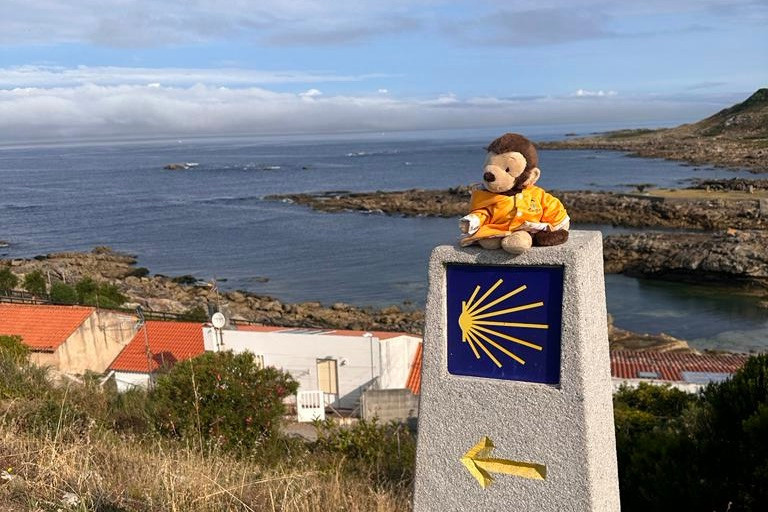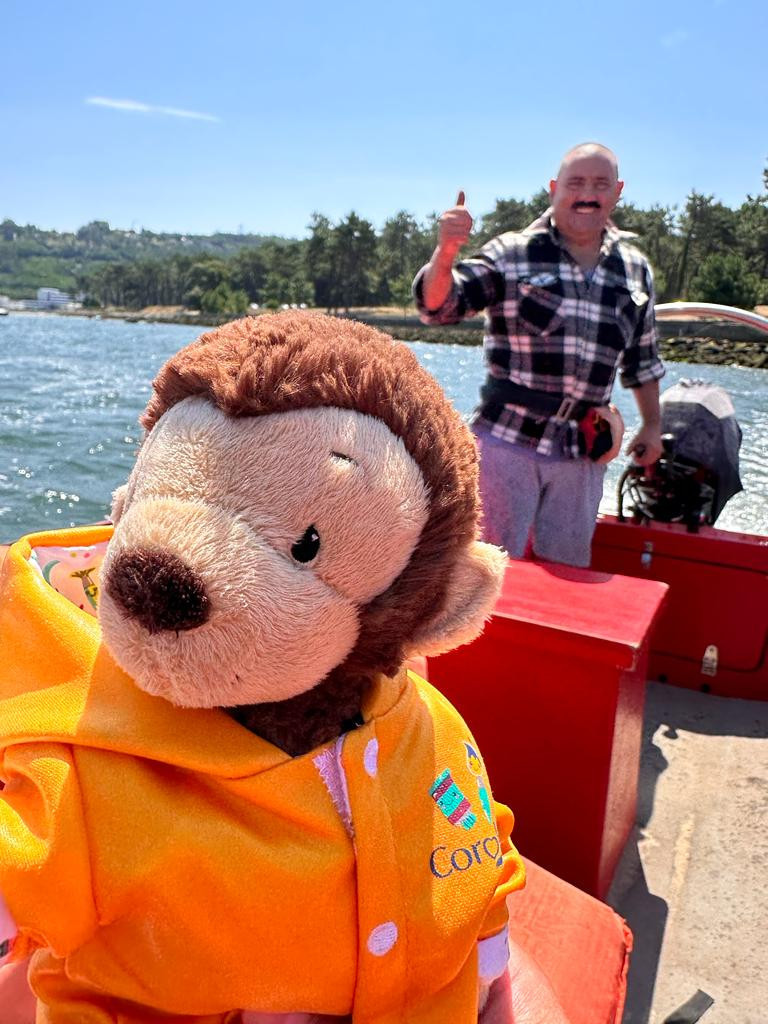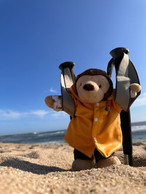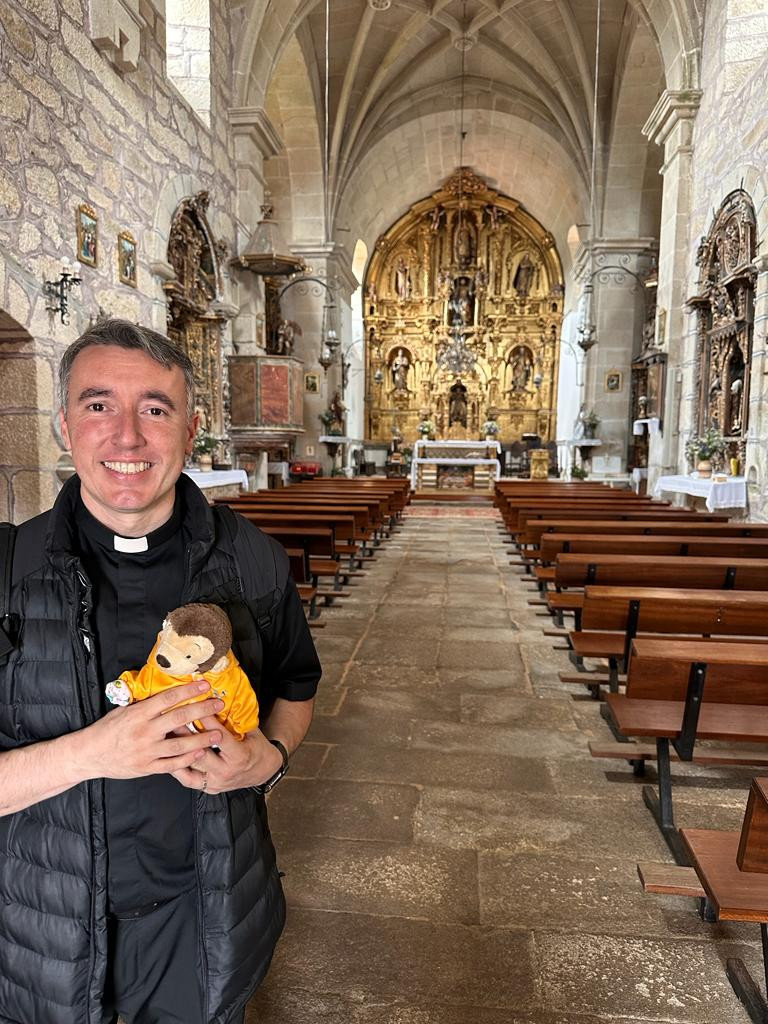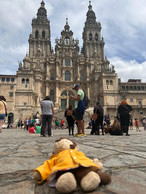At the start of my Teams interview with Darren Robinson, he holds up a small stuffed monkey wearing a yellow coat and introduces me to Lucas, who accompanied him on the Camino trail. I mention, with a laugh, that it was actually Lucas who had caught my eye in the that Robinson had made to document his trip. What, I ask, was the main motivation for their 259km trek through Spain and Portugal to reach Santiago de Compostela?
“I wanted to do something for one of our team members--Aude François--who’s worked with me since 2007, 2008,” answers Robinson. He explains that last autumn, Louis, François’s nine-year-old son, was diagnosed with leukaemia. Louis, however, was allergic to the treatment that is normally used to treat the cancer, and had to undergo intensive, intrusive therapy involving spinal injections and steroids, which caused side effects such as weight gain and hair loss.
“The poor little guy went through some horrible treatment,” Robinson adds. “Fortunately, he’s coming out of it really well, and actually is going to start school again in September.” Louis still has to go through quarterly spinal injections, “but he’s on the mend.” Although he’s not yet 100% fit and has to be careful about managing his immune system, Louis was even able to participate in a small football match recently.
Raising money for cancer charity
“Aude has been off taking care of him all that time,” Robinson continues, before adding that she’ll also return to work in September. “She’s gone through a tough time herself.”
All this time, however, Luxembourg’s Fondatioun Kriibskrank Kanner has been supporting the family, mainly with mental and emotional support such as providing advice on work and schooling, says Robinson. “So that was the motivation behind [the Camino walk].” The idea was to raise money for the foundation via donations from friends and family, but also through the Anderson Wise firm, which supports charities every year.
Why the Santiago de Compostela?
The Camino de Santiago (the Way of St James in English), is a well-known pilgrimage route that leads to St James’ shrine in the cathedral of the Spanish town of Santiago de Compostela. One of Robinson’s son’s teachers had actually done part of the Spanish Camino trail last year for charity, a trip that Robinson had followed on Facebook. “And I thought that could be a great opportunity.”
After exploring different options, he settled on a 259km route that started in Porto, Portugal and took 13 days in total. “I did think of a month,” he adds, “but I’m glad I didn’t. Two weeks was tough!”
Lucas the monkey: a “travelling gnome”
How did Lucas enter the picture? “I don’t where I got the idea from,” Robinson admits. “Somebody said there was some guy who travelled around the world with a gnome. Do you remember that?”
I reply that the concept does ring a bell, mentioning the 2001 film Amélie. The main character in the movie gives a garden gnome to a flight attendant friend, who takes snapshots of the gnome in different locations around the world.
Robinson doesn’t remember the film, but says that it could be the inspiration. “Clearly it wasn’t my original idea!” he says. “But I asked Aude whether her son had a soft toy that he cared about that would like to join me on the Camino.” And that’s where Lucas--a monkey who is one of Louis’ favourite cuddly toys--came in.
The stuffed monkey was “certainly a conversation starter” with a lot of other pilgrims on the trail, adds Robinson. Going from Spain to Portugal involved crossing a large river via ferry, for instance. As he was taking a picture of Lucas on the boat, two Italian women asked about the stuffed toy, which gave Robinson the chance to talk about Louis’ illness and the motivation behind his journey.
Three or four days later, “I was walking along, as I did every day,” says Robinson, who had the stuffed monkey hanging from the back of his rucksack. “And I heard two women shouting, ‘Lucas! Lucas! Lucas!’” After a moment, he recognised the two Italian women from the ferry a few days earlier. “I hadn’t seen these ladies since then, and of course, they didn’t remember my name, but they did remember Lucas!” he laughs. “He’s super famous!”
Not a “walk in the park”
The encounter with the two women from the ferry was one of the many “nice moments” on the Camino trail, says Robinson. “There was another moment where I was in a church, because it is about attempting to be spiritual, let’s say, and you know, there’s a lot of churches along the way, and there was one I stopped in where a priest had just finished [Mass], and he asked about Lucas.” Robinson had to get a translator because his English wasn’t very good, but the priest was happy to take a photo with the monkey. “It was really beautiful.”
On the physical level, however, the trail was tough.
“The thing that surprised me was that, I actually, genuinely thought it would be a walk in the park. It wasn’t. It wasn’t at all,” says Robinson. “We’ve all gone out and walked 10 kilometres through the forest in Luxembourg, and sometimes we may get to 15 kilometres, and, you know, it’s fun, it’s enjoyable.”
But the first few days of the Camino trail were “agony.” Robinson had an 8-10kg rucksack for the two-week trip and “wasn’t used to carrying weight.” “I was carrying a bit of weight on my belly as well,” he notes with a laugh, before adding, “I lost a little bit of weight, which was good!”
“But the blisters came, and they were incredibly painful. Even though I had bought blister prevention socks, they didn’t work. I had to pop my blisters every night. My feet are a mess, I think I’ve lost a toenail as well. Clearly I’ve got delicate feet these days!”
A 6-minute stroll becomes a 25-minute challenge
“Thirty kilometres a day with 10 kilos on your back--it becomes a different walking experience altogether,” says Robinson. “Once the blisters are popped and you walk on them, it’s painful, but you just get used to it. But I got shin splints [an exercise-related pain along the tibia] on about day three. And it’s the most painful thing ever.”
“There was one day that I walked, I think it was around 25 kilometres. And what should have taken me five hours, I think took nine. I remember dragging myself to the hotel in so much pain,” says Robinson. “I needed to eat because I was starving. Then my GPS said this restaurant was six minutes away, but it took me 25 minutes to get there because I just couldn’t walk properly. I was dragging this leg behind in so much pain.”
“It took me even longer to get back to the hotel,” he continues. “The next [day’s] trek wasn’t actually so long. But I thought it might take me about 12 hours, the way I’m going to walk tomorrow, if I’m like this.”
There was nothing that was going to stop me walking.
“There was nothing that was going to stop me walking. But I knew I’d have to walk slowly and in a lot of pain, and sort of dragging my leg behind. And I sat on that bed just thinking, ‘It’s going to be so painful tomorrow. What on earth am I doing?’”
Last three days “hardest” but “most enjoyable”
“I woke up that morning, without any pain at all. I could not understand it! It was just bizarre.” Robinson says he strapped up his knee and shin, put on his rucksack and thought, ‘This is so strange. There’s just no pain.’
“Maybe my pain threshold has changed, or something. But actually, from then on, the journey got more enjoyable. And people that have done the Camino before--much longer [routes]--have said that the first week is the most painful, and it’s your body adjusting,” says Robinson. “They’re absolutely correct.”
“The last three days were certainly the hardest, but they were the most enjoyable. And I thought that I could have gone on for another two weeks, knowing that after the first week I thought I was broken and thought I’d taken on too much.”
Listening to audio books vs. the “inner me”
For the first part of the trek, Robinson says he thought “it would be nice to listen to the ‘inner me.’ What was I going to discover walking on my own for so long? Because of course, I’d never done that before.”
But “all I was listening to for the first week was how awful this walk was, and how much in pain I was. That’s all my inner voice was: just moaning!”
Then, he switched to an audio book written and narrated by Lady Brenda Hale, who will speak at the Winston Churchill memorial lecture organised by the British-Luxembourg Society, which Robinson chairs, later this year.
“She’s fabulous. I listened to her book for three days, and that was so much better, because it took my mind off the pain. Not only that, she’s an inspiration,” says Robinson. “And because she actually reads the audio book, I thought I actually got to know her.”
He also read Heather Morris’ “harrowing” but “beautiful” book--Three Sisters--in the evenings, which tells the story of three Slovakian sisters who were imprisoned in Auschwitz by the Nazis. “I finished that book during the journey, which again, puts my pain into insignificance compared to what these people went through.”
Three Sisters also served as a conversation starter, says Robinson, “because I’d be reading this book and tears would start while I was at the bar.”
“Maybe going through the pain, and maybe going through all these things made me more emotional,” says Robinson, looking back on his Camino experience. “Especially, of course, as I’m doing it for this charity [Fondatioun Kriibskrank Kanner] that is looking after families and young kids who are, a lot of the time, terminal. It’s quite a special charity.”
Santiago de Compostela: the finish line
“The last two or three days, I listened to music as well. And I must admit, that really helped,” says Robinson. “I thought, ‘Why didn’t I do this for the first week? Why was I trying to listen to my inner self?’ I could have just been listening to great music and bounced along much more comfortably than I had for the first week!”
And then, the arrival, 259km and 13 days later.
“Walking into the cathedral at the end in Santiago, it was just so nice to get to the finish line. It’s such a beautiful city. It’s a city you just go to anyway, because it’s just a beautiful, beautiful place.”
As of this writing, Robinson’s Gofundme campaign for the Fondatioun Kriibskrank Kanner has collected around €5,000 in donations, and Anderson Wise will top that up to €10,000. The firm plans to present a check to the foundation’s director on Tuesday 29 August, and, if his immune system allows it, Louis will be at the event as well, along with Lucas the monkey. All the donors to the campaign have also been invited, adds Robinson, in order to thank them for their generosity.
You can donate to Lucas and Robinson’s Gofundme campaign to raise money for the Fondatioun Kriibskrank Kanner .
